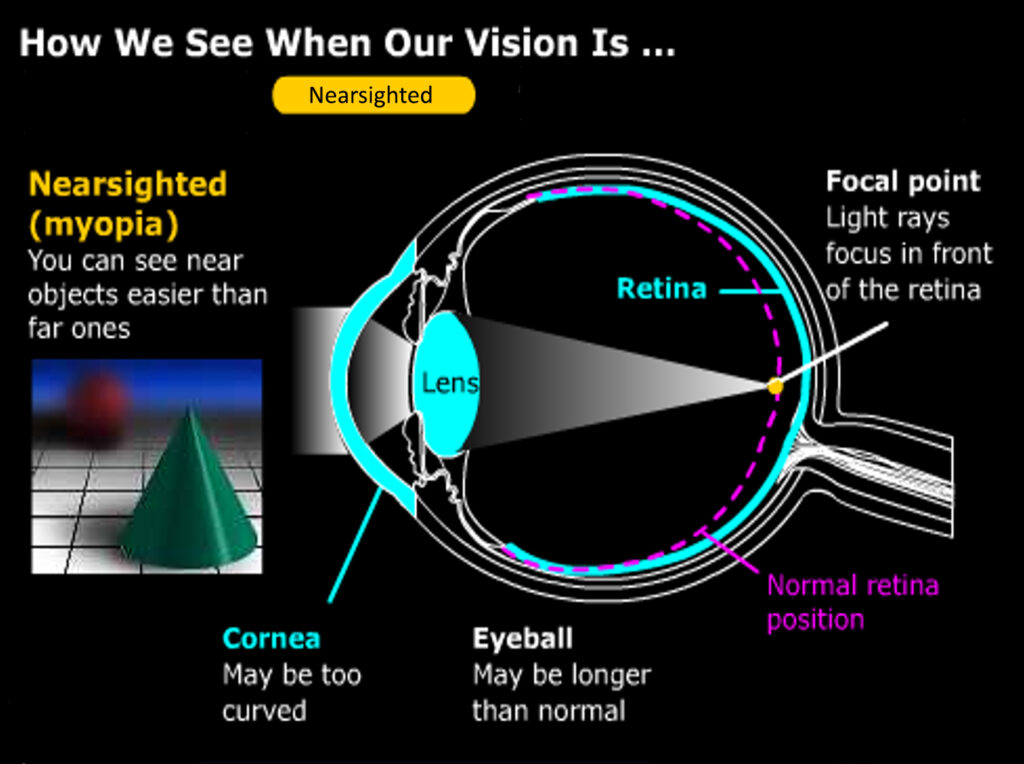Myopia
Nearsightedness (Myopia)
Nearsightedness is a refractive error (Glasses Prescription/Contact lens prescription) that makes people blurry in the distance. This common vision refractive error is further detailed by Dr.Gulani and his advanced diagnostics to better study and then uniquely approach with a custom designed surgery for your individual eyes.
In this continued desire to steer colleagues away from “cookie-cutter” surgery, he has given birth to KLEAR™, which involves over 40 techniques and infinite permutations to help people see without glasses by using breakthrough technologies (including Lasers, Lens Implants, etc.) singly and in sequence using his GPS™ therewith custom-tailoring surgery to each patient’s eyes to even aim for vision beyond 20/20.


After advanced diagnostics and clinically evaluating your eyes, Dr. Gulani classifies Myopia into:
- Mild
- Moderate
- Extreme
Additionally, he looks for causative anatomy to further break it down to:
- Corneal (when shape of your cornea is very curved/ steep)
- Axial: When length of your eye is longer than normal
- Lenticular (when your natural crystalline lens contributes to it)
As one of the most prevalent vision errors, nearly 40 percent of the population in the United States is diagnosed with myopia (nearsightedness). Myopia is a refractive error that leads to problems with an inability to focus on objects or images that are not close to the eye. This means that far-away objects or focal points may appear blurry, or the person with myopia might lack the ability to perceive them at all. People who have myopia can generally see pretty well with near vision but have problems seeing far-away items, such as road signs while driving, chalkboards at work or in the classroom, or movie screens.
Symptoms
Most common symptoms a patient of myopia may complain of is hazy vision that occurs when trying to focus on objects from a distance. You might also deal with other problems that stem from habitual squinting or eye strain. Eye strain, also referred to as eye fatigue or asthenopia, could cause aching or dry eyes. It might also cause intolerance to light and strain in the shoulders and neck. Sometimes, people who already use prescription lenses for myopia notice these symptoms. These signs usually mean that your eye prescription needs to be updated. To enhance your vision and improve your range of sight, you should receive an eye exam at your earliest convenience.
Causes
Besides anatomical elements impacted in the eye, myopia can be either inherited or caused by environmental factors. The hazy vision that comes along with nearsightedness is caused by the abnormal shape of the cornea or the eyeball. When the eyeball is longer than normal front to back, or when the cornea is too domed, any light entering the eye won’t be aimed properly onto the retina. In general, nearsightedness begins to develop in school-aged children, especially in children who are genetically predisposed. Nevertheless, adults may also develop myopia due to environmental factors or other health conditions.
Lately a few studies have proven that myopia can be associated with concentrated reading and writing over lengthy periods of time (like in study or professional contexts), avoiding the outdoors, and particularly, taking too much time to read content on mobile devices. Myopia can also be caused by changing blood sugar levels in those with diabetes.
Treatment

Using Advanced Diagnostics and years of clinical acumen, Dr.Gulani first determines what kind of astigmatism you have then picks among the full spectrum of surgical and technological options to design a procedure to best correct it and can even help patients with extreme Astigmatism using technologies and techniques he has helped pioneer and uniquely design combination surgeries.
In many cases, vision refractive errors (glasses contact lens prescriptions) may co-exist together (i.e. astigmatism with nearsightedness). Having taken even a so called routine vision disorder such as astigmatism and further studied it as regular, against the rule, or irregular, Dr. Gulani then sets about to apply KLEARTM involving over 20 laser techniques and nearly 40 vision corrective surgeries with unlimited combinations like an artist to custom-design a surgery and technology for your unique eye and vision error aiming for the best vision outcome he can.
We welcome you to set up your personal consult with Dr. Gulani so you can understand your eyes like never before and participate in selecting your best surgical option to then begin your Gulani Vision Experience.






